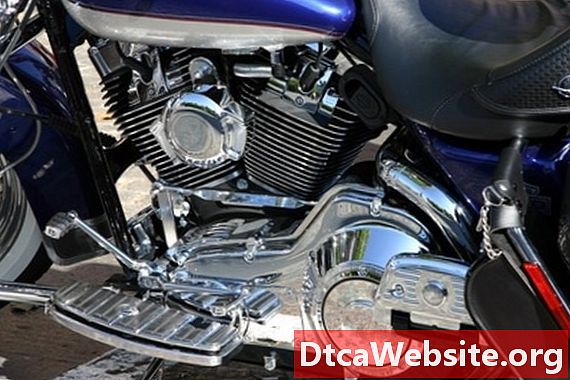
Contenu
- Preparation
- Step 1
- Step 2
- Step 3
- Step 4
- Step 5
- Step 6
- Assembly
- Step 1
- Step 2
- Step 3
- Step 4
- Step 5
- Tip
- Items you will need

If you need to protect your trailer cargo from the elements, you can build your own enclosed trailer from parts obtained at your local lumber store, saving you the cost of a commercial enclosure. The enclosure can be built from minimal parts, such as plywood sheets, 1-by-4 boards and fasteners. Most trailers are equipped with metal stake mounts welded to the inner sides of the frame. Once constructed, plywood walls can be mounted to the frame, enclosing your trailer. Prepare the materials and assemble your homemade trailer enclosure over a weekend.
Preparation
Step 1
Measure and note the separation distance between each stake mount pair, welded to the four inner sides of the trailer frame. Measure from the inside edges. Respectively, the side mount pair and front and rear mount pair measurements should match.
Step 2
Measure the insertion depth of the stake mounts. This distance should be between 3 and 5 inches, and will determine the extra board length for mounting the plywood walls to the trailer.
Step 3
Cut six 1-by-4 boards to a width matching the separation distance between the side stake mount pairs. Cut six 1-by-4s to a width matching the separation distance between the front and rear stake mount pairs. These boards will be mounted horizontally to frame the plywood walls.
Step 4
Cut eight 1-by-4 boards to a length of 4 feet plus the stake mount insertion depth. Each board length should measure between 51 and 53 inches, depending on the insertion depth required. These boards will fasten vertically to the plywood walls, and will mount the walls to the trailer frame.
Step 5
Frame the two 48-inch-square plywood side walls. Lay three horizontal 1-by-4 boards, cut to the side stake mount separation width, at the top, middle and bottom centers of each plywood board. The three boards should be centered, with an equal amount of plywood board on either side. Fasten the 1-by-4s to the plywood with a screw gun, using two wood screws per end.
Step 6
Lay two vertical 1-by-4 boards along either side of the horizontal 1-by-4s that are attached to each plywood side wall. Allow the excess board length to extend past the bottom edge of both plywood walls. Fasten the boards to the plywood with a screw gun, using two nails each, at the top, middle and bottom of the boards. The 1-by-4 framing should resemble a step ladder, with two leg extensions at the bottom of each board.
Frame the two 38 1/2- by 48-inch front and rear plywood walls using the same procedure that was used for the side walls. Orient the boards with the shorter sides horizontal. Fasten three horizontal 1-by-4s to the top, middle and bottom centers of each plywood board using wood screws and a screw gun. Fasten two vertical boards against either side of the horizontal boards, using wood screws and a screw gun. Make sure to allow the excess length of the vertical boards to extend past the bottom of the plywood.
Assembly
Step 1
Fit the 40-by 48-inch plywood board flat to the trailer frame. Drill 3/8-inch screw holes through the plywood to accommodate the frames mounting holes. Fasten the board to the frame using lag screws and a socket wrench.
Step 2
Mount the front and side walls to the trailer frame by inserting the vertical extension legs into the corresponding stake mounts. The 1-by-4 sides of the plywood should face inward.
Step 3
Apply a line of glue along either vertical edge of the front wall. Drill 3/8-inch screw holes to accommodate two equally spaced steel angles along each front corner. Fasten the steel angles using lag screws and a socket wrench, sandwiching the front wall between the two side walls.
Step 4
Apply a line of glue along the top edges of the front and side boards. Place the 40-by 54-inch ceiling board atop the three-sided box. Allow the 54-inch excess length to extend past the rear of the trailer. Drill 3/8-inch screw holes to accommodate two equally spaced steel angles along each of the three horizontal corners. Fasten the steel angles using lag screws and a socket wrench.
Step 5
Mount the rear wall by inserting the vertical leg extensions into the rear stake mounts. Drill 3/8-inch screw holes to accommodate two equally spaced rotating hasp hinges along either corner, where the side walls and rear wall meet. Fasten the hinge components to the edges of the side walls and the corresponding rotating cylinder components to the rear wall, using lag screws and a socket wrench. The hasp hinges should latch over the cylinders, and the cylinders should rotate, locking the hasps in place. This will secure the rear wall during travel and allow quick removal for loading.
Weatherproof the enclosure by applying silicone sealant along the front and top corners and around all the lag screws. The rear ceiling overhang should deter runoff water from entering the rear wall.
Tip
- To further weatherproof the enclosure, install waterproof rubber bushing around the outer edge of the rear wall using screws and a screw gun.
Items you will need
- Utility trailer, 40- by 48-inch frame, with stake mounts
- 1 plywood board, 3/4-inch thick, 40 inches by 48 inches
- 1 plywood board, 3/4-inch thick, 40 inches by 54 inches
- 2 plywood boards, 3/4-inch thick, 48 inches square
- 2 plywood boards, 3/4-inch thick, 38 1/2 inches by 48 inches
- 80 feet of 1-by-4 board length
- 10 stainless steel angles, 2 inches by 2 inches by 3 1/2 inches
- 4 stainless steel rotating hasp hinges
- 72 lag machine screws, washers and nuts, 3/8-inch diameter, 1 3/4 inches long
- 96 wood screws, Phillips head, 1/4-inch diameter, 1 inch long
- Power drill and a 3/8-inch bit
- Socket wrench and socket set
- Screw gun, Phillips head bit
- Circular saw
- Tape measure
- Wood glue
- Silicone sealant
- Safety goggles


